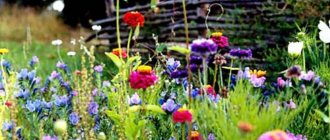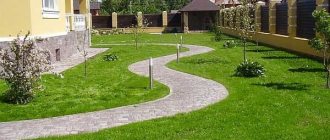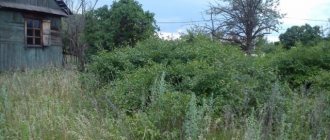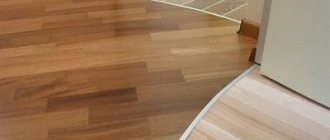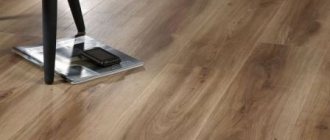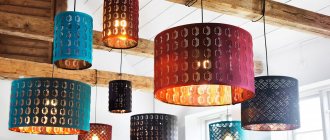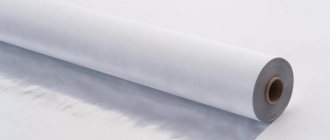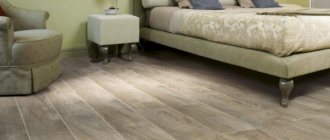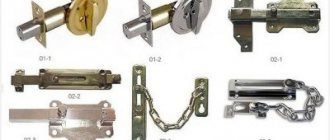↑ What is artificial turf
Artificial turf grass is a synthetic surface. The basis of artificial turf is polypropylene. “Blades of grass” (synthetic threads), which are coated with silicone, are attached to the base in a vertical position. There is a rubber backing at the bottom. Drainage grooves are laid at the top so that snow and rain water does not linger on the surface, but flows off the surface.
Artificial lawns today are produced of high quality; they look similar to natural grass.
Most often, such synthetic coating for landscaping is sold in rolls. The roll form of the grass makes it much easier to lay.
Synthetic fibers are attached to the artificial turf base during its production process. Depending on the purpose of the lawn, the blades of grass have different densities and thicknesses.
Most often, the villi reach a height of 6 to 10 centimeters.
The color range is also extensive - you can choose any shade of grass for your lawn.
Artificial lawns are divided according to the laying principle:
- non-filling;
- half-fill;
- backfill.
↑ Unfilled artificial lawns
This type of lawn always looks very natural and attractive; it is difficult for inexperienced people to distinguish an unfilled lawn from real grass.
This coating is used when decorating areas where almost no one walks.
They try to fence off such a lawn, since when walking on it the grass will not “live” for a long time.
↑ Half-fill
Such synthetic “grass” coverings are intended for the design of all kinds of playgrounds and children’s playgrounds, sports (football, for example) fields.
The base of the lawn is made from very soft polyethylene threads, which significantly soften the impact of a fall.
When buying a semi-fill lawn, you must pay attention to the quality and strength of the material.
When laying, the spaces between the fibers are filled with quartz sand.
↑ Backfill
Artificial infill lawns are used for landscaping, in addition to summer cottages and home areas, also for laying on football fields. When using a semi-fill lawn, it is evenly sprinkled with quartz sand with a fraction of up to 0.6 mm.
In addition to sand, rubber granulate is needed for laying a backfill lawn.
This material perfectly protects against bruises and injuries from any falls.
Substrate preparation
The soil for lawn grass should be loose and porous with a neutral acidity level. The substrate can be purchased at a specialized store, or you can prepare it yourself. To do this you will need sand, silt and clay in proportions of 2:2:1. At the bottom of the box it is necessary to lay out a layer of drainage made of expanded clay, balls, pebbles or other materials. The drainage components should be doused with boiling water for disinfection purposes, and the substrate itself should be calcined.
↑ Advantages and disadvantages of artificial turf
All synthetic lawns have advantages, including the following:
- spectacular and aesthetic grass covering lasts for a long time;
- the lawn is used in open and closed areas throughout the year;
- the coating is highly resistant to all kinds of natural factors;
- artificial turf protects any area from the growth of weeds;
- “grass” is not afraid of excess moisture;
- Artificial turf is not difficult to maintain;
- “grass” does not need regular watering and fertilizing, unlike a real lawn.
Among the disadvantages is the very high price of the material. If the cost of artificial turf is low, then most often it is of poor quality.
An unpleasant fact during operation will be the heating of the lawn at high temperatures.
After all, the coating is based on synthetic fibers, and they tend to heat up under the rays of the sun. And the last drawback is that if you get tired of the old artificial turf, it will take a lot of time to replace it with a new lawn.
Basil
Basil is good for everyone, it’s an excellent seasoning, but gardeners know how difficult it can be to grow it from seeds. In the middle zone you need to bother with seedlings, but there is always enough space for them. But you don’t have to do this!
If you have basil growing on your property, dig up one or more bushes and plant them in pots. They will grow on a bright windowsill all winter. Tear off the bottom leaves as needed and use as a seasoning.
Gradually, the basil will stretch out, the shoots will become bare, but this is not scary - cut the bushes by 2/3, and after a while they will grow back.
The ideal place for basil at home is the kitchen.
In the spring, cuttings can be taken from these bushes, rooted and planted in garden beds.
↑ How to care for artificial lawn
Before laying artificial grass, be sure to familiarize yourself with the rules for caring for it. There are no difficult aspects of care; it is enough to follow the basic requirements. Due to the fulfillment of the conditions, the service life of artificial lawns is significantly increased.
- The lawn must be used for its intended purpose. If the artificial turf is intended for decorating a summer cottage, playing field, etc., then there is no need to subject it to increased mechanical loads as a result of everyday use.
- To connect the seams, you need to purchase a special glue that will fix the strips very firmly. It is better not to use cheap glue.
- The finished artificial turf must be washed and dirt removed regularly. Especially that “grass” that covers the playground.
- It is necessary to minimize the entry of construction and household waste onto the lawn, since ideally removing it from the surface will be problematic.
- Once every six months, it is recommended to replace quartz sand and granules in semi-filled and infill lawns.
- Since there is no point in leaving a lawn on the site in winter, the rolls are removed until spring.
- When an artificial lawn is used quite often, it will have to be updated more often.
- If for some reason the lawn covering is damaged, the damaged area is isolated until it is completely restored. There is no need to allow the problem to worsen and continue to exploit this area.
- Once a week, the grass is slightly moistened, especially if the weather is too hot.
- Every two weeks, punctures are made in the artificial turf. This way you can protect your lawn from mold.
- Weeds sprouting from under the “grass” must be removed; they must not be allowed to grow on the surface of the lawn and disturb the evenness of the surface.
Do not install objects that are too large or heavy on the artificial turf as they could deform the pile and ruin the appearance of the lawn.
It is forbidden to drive onto surfaces with synthetic grass by motorized or motor vehicles.
The exception is special cleaning equipment.
You can rid your lawn of dirt using plain water. To remove leaves, you need a special rake. You can use a vacuum cleaner. But if the lawn is backfilled, then you won’t be able to use a vacuum cleaner, since it will begin to collect filler (quartz sand).
It is important to monitor the condition of the “blades of grass”, check the seams in order to notice the separation in time and solve this problem.
↑ What is needed for laying a lawn
To lay synthetic lawn, you will need the following materials:
- artificial turf;
- seam tape;
- polyurethane glue (two-component);
- substrate for coating;
- sand;
- putty knife;
- brush for removing glue;
- knife.
Artificial turf is laid on different substrates: soil, concrete, wood, brick.
How to prepare peppers for transplanting
You can start replanting peppers on the eve of a cold snap, after harvesting. It is worth cutting not only ripe fruits, but also green ones, since a plant strewn with fruits does not tolerate transplantation well. The fruits will take away the strength of the bush, which it will need to adapt to new conditions. You can leave several ovaries only on bushes with a small number of side shoots.
Tear off the lower leaves on the bushes and cut off those shoots on which the crop is not formed and there are no buds. If there are still many flowers on the plant, trim off the top shoots that are directed into the bush
Pay attention to the pepper leaves: remove those with spots, and treat the bush with a biological product based on Bacillus subtilis (Fitosporin-M, Alirin-B, etc.)
Carefully inspect the undersides of the leaves for aphids, spider mites and other pepper pests. If you find them, treat them with an appropriate preparation (for example, Fitoverm).
A few hours before transplanting, water the bushes generously with settled water and dig up the plants with a large lump of earth.
↑ Laying lawn on a concrete surface
Sometimes a concrete foundation needs to be installed on a site. Most often these are the following areas: a children's playground, an open terrace, a balcony in an apartment.
Most often, the design of a concrete base is carried out only in certain areas.
To glue the synthetic coating to concrete, you will need a backing. This will make your lawn last a couple of years longer.
As a substrate, you can purchase geotextiles or rubber coating.
Before laying the covering, the concrete base is cleared of debris. Then lay out the required amount of substrate. After that - lawn grass in rolls. There must be an air cushion between the substrate and the coating.
It's good when the base is made of polyester. It is necessary to ensure that the layers overlap each other by approximately 15 mm.
After this, the substrate and the lawn should rest until completely straightened. Then the materials are glued together using polyurethane glue and connecting tape.
If the lawn covering is laid using the semi-fill or backfill method, then additional backfilling with quartz sand and rubber granules is required. All edges are decorated with small borders.
Marking
If the artificial turf will be used as a sports ground, then markings will be necessary. This can be done in two ways:
— painting;
- “inset”;
The first option is more economical and easier to implement, but less durable. Such markings, applied with polyurethane paint, will last from 3 to 5 years.
The second option is more labor-intensive, but the service life of such markings is equal to the service life of the site itself. It involves inserting markings made of the same artificial grass, only white.
To install the ribbon, strips of the required thickness are cut from white blades of grass on a green field. Then a connecting tape is placed under the resulting edges of the lawn, polyurethane glue is applied to it, and the edges of the lawn and the white marking insert are carefully placed, avoiding the glue getting on the fibers. Everything is pressed carefully.
↑ Laying lawn “grass” on the ground
Installing an artificial lawn on the ground is a painstaking job and will require a lot of patience and effort. But the result is worth it!
To begin with, a plot of land is prepared. It must be completely clear of debris and weeds. Then the area is leveled.
Then the required number of rolls for their purchase is calculated.
When laying turf, it is important that the ground is completely dry. If there are unevenness on the base of the soil, they are leveled. Do not lay the coating on areas with sand. There is a high risk that the “grass” will deform very quickly.
It is important to make several outlets for water under the coating.
The grooves will save the lawn grass from rotting. In addition to the grooves, a drainage layer of granite or crushed stone is also laid out.
When the area is prepared, begin rolling out rolls of artificial turf. The rolls are stacked tightly to each other.
The rolled out lawn covering is left in this form for a day so that the lawn takes on the correct shape.
Then all seams are rolled with a special roller. Seam tape is often used. It is secured at the joints using staples or glue.
For laying lawn grass on the ground, it is best to purchase the infill type. After laying, the entire lawn is covered with quartz sand.
Registration of plots
An artificial lawn created for a summer house or personal plot with your own hands solves many problems.
- The first is landscaping places that are in the shade, where it is impossible to grow natural vegetation.
- Secondly, masking visible parts of communications, spoiling the whole view, with the help of rolled lawn.
↑ Laying artificial grass on wooden flooring
The technology for installing synthetic lawn grass on wood flooring completely depends on the type of material.
Rolls or pieces can be secured using safety brackets, special glue or adhesive tapes.
There are options when artificial turf is “laid” on a wooden wall.
Before laying the lawn on a wooden surface, it is thoroughly cleaned of dust and debris and treated with anti-corrosion impregnations or primers.
In a natural way, the dried base is thoroughly coated with special glue and pre-unwound rolls of lawn covering are glued. They are placed with a slight overlap (up to 15 mm).
The rolls are then cut and sealed with seaming tape to create a perfectly even lawn. For reliability, you can use staples at the joints. You can also install a border made of building materials around the entire perimeter of the lawn.
Care
In addition to removing large debris, the coating needs to carry out the following procedures:
- carding. For straightening pile and removing small debris;
- piercing To improve the drainage of excess water;
- watering. For hydration;
- mulching. Renewing the top layer in places where flaws appear.
↑ Installation of artificial grass on a football field
For a football field, infill turf with a pile of 2 to 5 cm is used.
The process of laying artificial turf on a football field:
- Correct laying of the coating begins from the moment the rolls are unloaded. The better the artificial grass is preserved during the installation process, the longer the football field will last. Rolls of synthetic turf are unloaded as carefully as possible. You can use a forklift for unloading, having a pin three meters long and 10 cm in diameter.
- Artificial turf is laid on a hard base and on a sand and gravel base. For a football field, it is important that an elastic and durable substrate be laid, with a thickness of at least 0.8-1 cm. If you use a thinner substrate, you will not be able to lay out the lawn evenly, and bends cannot be avoided.
- When the substrate is prepared, rolls begin to roll out. The rolling out process must be carried out in strict accordance with the field plan. After rolling out, the lawn grass is left to rest for 10 hours. During this time, the artificial grass will fully expand and the rolls will take the shape of the field.
- The lawn sheets are laid with an overlap of 15 mm, then the edges are cut so that the rolls fit millimeter to millimeter.
- When they achieve an even and precise fit at the joints of the rolls, they begin to glue the different parts together. It is important to remember to trim the edges. Then the edges of each canvas are turned back and a connecting tape is laid. The junction of the canvases should be in the middle of such a tape.
- Polyurethane two-component adhesive is applied with a spatula. After applying the glue, the edges of the canvases are carefully lowered. Before the glue completely hardens, you need to lift up all the fibers that accidentally bent inward. Each seam must be rolled using a roller.
- Not all fields have marking lines sewn into them. Then the line must be sewn in, but only when the grass cover has completely stuck together. Sewing requires strips and a double-bladed tool. You will need it to complete the markings. Coat the strips with glue, and then carefully insert the strips.
- The next stage is filling the lawn grass with sand. Use quartz sand with a fraction of 0.3-0.6 mm. Filling is carried out in dry weather. In accordance with the norm, sand is consumed per 1 m2 and distributed evenly throughout the lawn. Then the grass is combed. During this procedure, the sand will settle.
- The last stage when installing artificial grass on a football field is additional filling with rubber granules, followed by combing the lawn surface. It is better to use rubber or rubber granules with a fraction of 1-3 mm. If you use the football field regularly, you will have to repeat the filling with granulate after 4-6 months.
The permissible air temperature at which it is allowed to operate a football field is from –30ºС to +50ºС.
Infill synthetic lawn must be regularly cleaned of debris; do not forget to remove debris with a rake several times a year.
Gluing the canvas
Once you are sure that the lawn fabric lies flat and has no defects in the form of swellings or bumps, you can begin gluing the parts together.
To glue parts of the lawn together, special connecting tapes (sutures), about 30 cm wide, and polyurethane glue are used.
The tape is placed under the edges of adjacent parts, glue is applied to it with a notched trowel, the edges of the sheets are lowered, and the seams are pressed with a roller or heavy pipe of a suitable diameter.
The work should be done carefully, avoiding getting glue on the lawn fibers.
If the lawn area is large, it is advisable to additionally secure the seams with staples.
↑ Laying artificial grass at the dacha
Installing an artificial lawn at your dacha is no different from laying artificial turf on the ground. The soil base is prepared in the same way. Don’t forget to drain the water so it doesn’t accumulate under the artificial lawn.
A drainage layer is also made from crushed stone (or granotsev).
After laying the rolls, they are left to rest for a day and take on a new straightened shape.
It is recommended to secure the edges with a mounting stapler.
For the winter, the rolls can be carefully rolled up by removing all the staples. You only need to roll up a dry covering, otherwise there is a risk that it will become moldy over the winter.
If the lawn covering is left to winter, then when the ice freezes, you cannot scrape it off the surface of the lawn with a shovel. This will lead to damage to the coating; such areas may need to be replaced in the spring.
Artificial turf is a great innovation and a good alternative to natural grass. Artificial turf is easier to maintain, it does not wither or grow. It is enough to decorate the area with artificial grass once, and the lawn will decorate it for many years.
The triumphant return of the ficus - new botany in the interior
How did it happen that in 2021 designers turned to indoor plants? This became a logical continuation of the idea of ecological phytodesign of the interior, which the Japanese and Scandinavians have never changed. The need for natural materials, natural forms and islands of nature inevitably resulted in an interest in house plants and the search for their new role in home decoration.
The revolutionary direction was called “new botany”. It has penetrated into the interior of all existing styles, from urban to country, from minimalism to classic.
The mission of indoor plants is to harmonize the design of the home and bring a new melody to it.
Indoor plants will bring a fresh note to the interior
How necessary are indoor plants in the interior of an apartment decorated in a certain style, and which ones should you give preference to?
Beautiful examples in the interior
With the help of indoor plants, you can make your apartment attractive, stylish, cozy, where both you and your guests will be very comfortable and pleasant to stay.
And for this you need to master such a simple science as phytodesign. And then you will be able to create magnificent compositions and beautiful oases that will become bright splashes even in the grayest everyday life and will lift your spirits even on a cloudy and rainy day.
Let's look at some successful examples:
- The bottom of the trunk in a floor cart can be decorated with moss or green climbing plants.
- On the windowsill you can place a composition of several potted flowers. If we do this on the floor, then in the center there should be a specimen slightly larger than its counterparts. The rest are arranged in tiered order, it is desirable that flowering plants are present there.
- Phytodesign is a constantly evolving area; over time, original new products appear that quickly gain popularity among gardeners. Thanks to this, you can realize your wildest ideas and feel like designers in your own apartment.
- One of these new products is florariums. Tropical plants are located inside transparent vessels. Another fashionable trend is rutaria. The basis for installing plants in pots are tree branches, stumps, and roots. It all looks very unusual and at the same time natural.
- As for the color scheme, you yourself decide what will go best with your wallpaper, curtains, furniture and other parts of the interior. But there are several universal shades that can suit many.
- So, in the kitchen, yellow and green plants will create a special cheerful mood, as well as coziness and comfort. Fragrant and fragrant flowers will complete the look.
- Roses, irises and freesias will bring peace and relaxation to the bedroom. You will be pleased to be among these flowers.
- White, yellow and pink flowers will give you a feeling of harmony. A romantic setting calls for splashes of red. Also, bright flowers will give energy and strength. Blue and purple plants will relieve stress and fatigue.
- Lilac will give you freshness; it is recommended to place it in a vase with a wide neck. In addition, it will serve as a good background for other plants. Or you can supplement it with a sprig of viburnum.
- Dahlias look light and fresh, they do not fade for a long time and look very natural in any room. You can collect several shades in a vase, and this will add liveliness to the interior.
- Wildflowers in wicker baskets will add romance, and chic buds in elegant vases will add sophistication.
- Roses have special requirements: light flowers harmonize well with white vases. Dark tones look elegant in black, silver and gold vessels.
There are many options. Plunge into the beautiful world of flowers and create your own unique oasis in your apartment or house.
To learn how to make a florarium with your own hands, see the following video.
Which to choose
Strange as it may seem, there are a huge number of types of carpets that imitate grass. And the choice of this flooring depends on several factors.
- Carpets differ in purpose. Modern golf or football grounds are often covered with artificial turf. Modern designers suggest using this coating on the territory of the house, equipping it with floors on terraces or the ground in the garden. The grass carpet for use in open areas is made of polyethylene. It is not afraid of either rain or snow, it does not fade in the sun, and does not crush under the load of people passing on it. In the house they use softer imitations of green lawns, the pile of which is soft and pleasant for walking on the carpet barefoot.
- This floor covering is divided according to the length of the pile. If it is preferable to use carpets with a short pile outdoors, then in the house with a higher one.
- Models have different lint densities. The appearance of the carpet depends on the padding. The thicker the pile of a product, the better it looks. Of course, the price of such a sample will be much higher.
The choice is also influenced by the required shape. You can cover the entire floor of the room with this covering, or select a certain corner of the room and organize a green oasis there.
The purpose of the room in which you plan to lay the grass carpet also plays an important role when choosing this product. Moreover, not only the shape and size of the carpet, but also the length of the pile and what it is made of depends on the type of room.
So in the living room or in the children's room you can decorate the floors completely with this product, although a green island in the form of a carpet-clearing is also acceptable in these rooms. At the same time, the product should have thick, long pile, and it should be pleasant to walk on.
In the hallway near the front door you can put a rug that is designed for laying outdoors. It can be washed if necessary, and at the same time, such an accessory will add color to the hallway.
It is better to lay a carpet that imitates small grass in the kitchen, away from the cutting table. Since this floor covering is easy to get dirty, and the green color shows dirt right away.
A “green lawn” is also appropriate in the bathroom. But for this room you need to choose materials that absorb water well and dry quickly. Cotton and bamboo are good choices.
Another selection criterion is the color of the attribute. It should fit well into the room. At the same time, a grass carpet can act both as an accent in the interior and support the color scheme of the room.
Fiber type
The first types of artificial lawns had fibers that took the form of grass only after adding stabilizing compounds between them.
The first types of artificial lawns had fibers that took the form of grass only after adding stabilizing compounds (special sand or rubber granules) between them. This artificial grass was called fibrillated and had low elasticity and wear resistance. Over time, manufacturers replaced fibrillated “blades of grass” with another type of pile - monofilament. It is elastic, that is, it maintains its original vertical position for a long time, and stabilizing bedding is not necessary for this, although it is used on some types of specialized artificial lawns.
Monofilament fibers are much more pleasant in terms of tactile sensations, in which they are almost as good as natural lawn grass. This pile is resistant to wear and tearing. The length of the fibers and their density per unit area of coverage depends on the purpose of the “grass” carpet. Carpet that does not require adding sand or rubber granules ranges from 4-8 mm. Some specialist artificial turfs can have a pile length of up to 70mm (for indoor rugby pitches, for example). The density of the pile is determined in grams per m2 of green covering. Inexpensive carpets have a density of 250-500 g/m2, elite ones - from 1.5 g/m2 and higher.
Scandinavian clean lines
In the Scandinavian interior, indoor plants carry the same load as large designer accessories: they give minimalism the charm of elitism. Each plant is “presented” so that it is the center of attention.
What new things have the trendsetters in the field of design enriched this style with? Lawns came into the interior. They have been used before in the Scandinavian style, but only selectively. Now the lawn is given a wall, a podium, and some other significant spaces. In continuous landscaping, cereals, moss, hanging plants and low leafy plants are used.
Interior landscaping in Scandinavian style
It was in the Scandinavian style that vertical hanging gardens were first used. They are framed like a painting. They create a picturesque carpet of stems and leaves of different textures. Built into niches. They replace the walls.
Vertical flower bed in a Scandinavian interior
Florariums – inventive mini-greenhouses for dwarf plants – effectively and organically complement the decor.
An extravagant way to present plants is hanging flowers from the ceiling. And a completely surreal example of phyto-interior design - inverted pots with stems growing downwards.
House plants on a windowsill in an apartment interior
It is traditionally believed that the window sill is the best place (and in small rooms, often the only place) for placing house plants in the interior of the apartment. There the plants receive enough light, air and heat, so in many apartments flowers are placed primarily on the window sills in the living room, bedroom, dining room or kitchen.
The size and location of the window sill is an important factor for growing flowers. Narrow window sills are the worst option. It is impossible to place lush plants on them or create a composition; the shapes of flower pots are also limited. There is a way out - expand the window sill or select for landscaping small plants with a shallow root system that do well in small pots.
You can use narrow flower racks, hang pots from the ceiling or in window openings.
In many apartments, the central heating radiator is located directly under the window sill. If the window sills are wide, this does not create any problems; it is much worse if the window sills are narrow. Warm dry air from the battery rises up to the window where the plants are located. As a result, air humidity, which is already low in winter, decreases.
Popular articles Features of the herbaceous plant alyssum
Using this method of plant placement, select crops that can withstand the dry air of apartments and spray them more often.
Most plants cannot tolerate cold drafts, so carefully seal any cracks in window frames.
If there is only one window in the room, it is better to purchase lightweight structures with shelves that are mounted in the window opening. It looks modern, does not overload the window, and allows light to freely enter the room.
To accommodate tropical, heat-loving plants, you can purchase or build a windowed indoor flower garden or a mini-greenhouse with heating and automatic water supply.
When placing plants on the window, remember:
- light-loving plants are placed closer to the glass (make sure that the leaves do not touch the glass), and more unpretentious ones - a little further away;
- climbing plants are best placed on the sides of the window, using various supports around which they will curl;
- tall plants are well interspersed with short ones;
- decorative-leaved and beautifully flowering plants can be combined into original compositions by adding flowering bulbous plants to them in winter: tulips, daffodils, crocuses, hyacinths, muscari.
